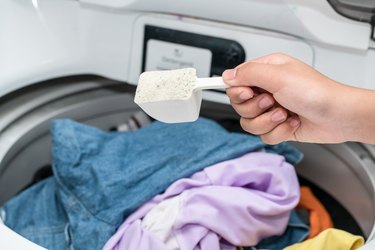How does a washing machine without an agitator work? If you plan to buy a high-efficiency, top-loading washing machine, start thinking about doing laundry in a new way. Like front-loading machines, these washers do not use an agitator to clean your clothes, saving water and energy but requiring a few changes in routine.

How They Work
In a traditional washing machine, an agitator twists and turns laundry in a tub full of water to get it clean. Top-loading, high-efficiency washers replace the agitator with low-profile wheels, discs, fins, cones or plates known as impellers. These moving parts cause the tub to spin or juggle the clothes gently at high speed in much less water. That means you're cutting down on water consumption to help the environment and your wallet. Some also spray the laundry with wash water or a rinse solution to boost the cleaning action. The fast washing speed also pulls more water out of the load of clothes, reducing time needed in the dryer and an additional reduction in energy use.
Video of the Day
Video of the Day
Detergent Differences
With a traditional top-loading machine that has an agitator, you can use any type of laundry detergent. With an HE top load washer, you need to be a little more picky. High-efficiency washers require detergent created for that type of machine. Don't use regular detergent. It causes excess suds that can cut down on cleaning power or even make the machine overflow. High-efficiency detergents work especially well in small amounts of water, which is important, because high-efficiency washers use as little as a fifth of the water of traditional machines. Read the owner's manual and directions on the detergent container to determine how much to use and whether to use a dispenser.
Laundry Additives
If you want to use water-softening, stain-removal or fabric-softening solutions, read all directions to ensure you use the correct amounts in the right way. Fabric softeners normally go in a dispenser in the machine, but use only rinse-added softeners. Regular pre-treating or soaking solutions often cause too many suds, so consider using your high-efficiency detergent to soak items instead. Add bleach and water softener following machine and package directions, but never mix liquids and powders, which can clog dispensers and reduce effectiveness.
High-Efficiency Washer Advice
Watch for wrinkling or bunching of clothes inside a top-leading, high-efficiency washer. The machines also typically cost more than traditional machines, although you will save in reduced use of water of energy. Greasy or oily soils in your laundry may collect inside the washer, especially if you use cool or cold water. Follow directions to run weekly or monthly maintenance cycles without any laundry inside to prevent buildup and odors.
When comparing a washer with an agitator vs. no agitator, it really comes down to how the clothes move around and how much water the machine uses. Making small adjustments to your laundry routine can make an agitator-free machine a more efficient way to tackle your family's laundry.